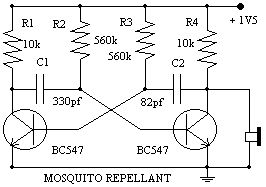
 |
| FlashWebHost.com | Resources | Ham Radio Circuits | Ham Radio | SSB Transceiver | |
They will be swarming once again, the unwanted, winged torturers, looking for the victims and leaving behind swelling and itch!
The mosquito problem is a part of everyday life, espacially during the summer.
Since the immemorial, inventive people have struggled hard to find effective means of protection against these insects. Even though it is a fact that only the females are dangerous, the males can also create situations of panic by their humming. Scientists say that these and many other insects find some particular frequencies of sound very unpleasent abd run away from these frequencies.
It seems quite obvious then, that by creating these insects frequencies electronically, we should be able to repel these insects! The most important point to remember here is that, unfortunately, this method has so far not been completely sucessfull. Whereas one group of insects can be made to run away at frequencies around 5 KHz, other types may desert only at higher frequencies, about 10 to 20 KHz. For some types, all the frequencies may fall on deaf ears! Yet other theories propose that in fact some frequencies may even attract them instead of repelling.
Whatever may be the truth, trial is superior to just theorising. Even though the cost of our circuit may prove to be a wrong investment, as the population of mosquitoes and insects who are immune to our insects/mosquito repellant is likely to be predominant ! The loss is very high - four resistors, two capacitors, two transistors and a buzzer.
The Astable Multivibrator, which is generally used as a signal generator, is once again used here to generate the desired frequencies. It is an excellent example of the fact, how versatile simple basic electronic circuit can be.
Let us quicklt see the operation of the astable multivibrator circuit. When T1 is conducting T2 is off and when T2 is conducting, T1 is off. The capacitors C1 and C2 contributes decisively to this ON/OFF cycles for the transistors T1 and T2. The time taken by C1 and C2 to charge and discharge decides the shape of the output waveform. Another important factor in the operation of the circuit is the fact that the transistor goes into conduction only when the base-emitter voltage exceeds 0.7 volts (for silicon transistors). From this basic knowledge we can visualise how the transistors exchange their roles and how the voltage on the collector of each transistor jumbs between the lower and upper level, producing a rectangular waveform. If you take a close look at circuit, you will notice that C1 and C2 are not equal. They differ in their values by afactor of four.
The output signal will thus be a non symmetrical waveform. Such a non symmetrical signal contains more high frequency harminics compered to the normal square wave signal. The output of our circuit will have the basic frequency of 5 KHz along with harminics of 10, 15 and 20 KHz. If some insects are deaf to frequencies upto 5 KHz, they may react to 10 KHz or 15 KHz or even 20 KHz, one never knows ...
The piezo buzzer used should not have an internal oscillator built into it. The circuit consumes 0.3 ma current, and can give about 1500 hours of nonstop operation.

R1,R4 - 10 K Ohm R2,R3 - 560 K Ohm C1 - 82 PF C2 - 330 PF T1,T2 - BC547 Piezo Buzzer (Without internal oscillator)
| Website designed by FlashWebHost.com. All rights reserved. |